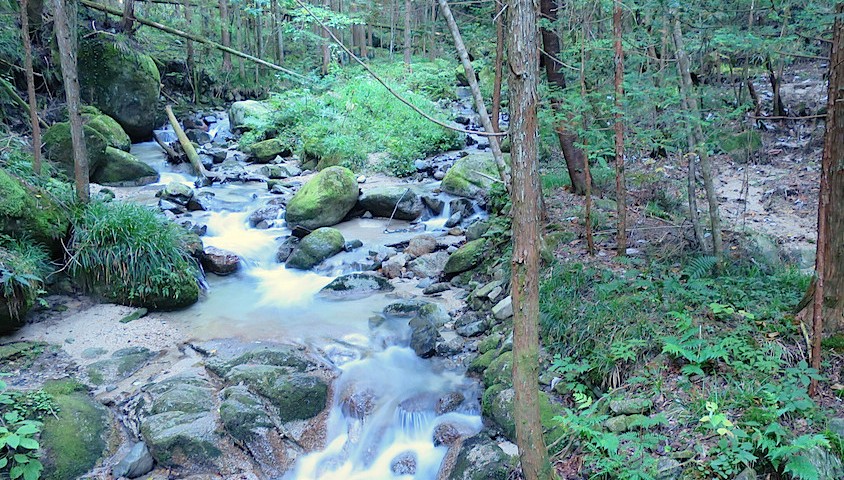‘Ring bell against bears,’ the hand-painted sign proclaimed, accompanied by a line of kanji and a cartoonish illustration of a bear, below which hung a brass bell.
“Maybe we should ring the bell, just in case?” Anna asked.
The path ahead slipped down through tall cedars on the shadowed side of the hill which, coupled with the bear warning, created a sense of foreboding. However, the sky above the canopy was bright blue and I could see our path would quickly emerge again from the gloom of the woods. Besides, I wouldn’t mind seeing a bear.
“How about we just go carefully?” I said. “The bears are sure to steer clear of humans and we’re not very far from the last town. It seems unlikely we’ll run into any.”
Within five minutes of beginning the descent on the darkened hillside, stepping carefully over the path’s rough stones, we heard a bell ring out clearly somewhere below us. A few minutes later another chimed out from the mountains ahead. It appeared there were more bells in these woods than bears, and more people besides. I wasn’t likely to get quite the wild experience I’d been hoping for.
My partner and I were descending into the Kiso Valley in Japan’s Central Alps, following the path known as the Nakasendo Way – the ancient walking route that connected Edo (now Tokyo) and Kyoto. The area is rich in cultural sites and offers a mixture of both alpine, rural and wilderness landscapes, so I had been looking forward to hiking in the region for a long time. A bear sighting would have taken the experience to another level.
Although Asiatic black bears (Ursus thibetanus) are present throughout Honshu (Japan’s largest and most populous island), I had discovered that their population is controlled by local hunting groups and individuals not due to be culled are scared away from population centres in order to minimise the chance of a negative encounter. The bells ringing in the woods of the Kiso Valley meant there was almost no chance of spotting one in the wild. In fact, I was more likely to sample bear meat at a local ryokan (traditional Japanese inn) than I was to see one on the loose.
The Nakasendo Way cuts a path stretching 534 kilometres through the middle of Honshu. For much of Japan’s feudal history this route (or the collection of ancient roads that comprise it) could be considered the major arterial, shuttling goods, people and information back and forth between the two major capitals. Due to the frequent friction that existed between Edo and Kyoto, the Nakasendo could almost be seen as a linchpin or perhaps a seesaw. It was the axis along which power between the west and east was balanced.
Throughout the Edo period (1603-1868), various Emperors found their court challenged by the rising power of a shogunate in the west. As history has shown in cultures the world over, these problems are most expediently solved with a fortuitous marriage between the two feuding families. At least seven princesses were married into the Imperial court during this era of Japanese history, delivered along the Nakasendo Way on lacquered palanquins. It is for this reason that the route has also been dubbed Hime no kaido, ‘The Highway of Princesses’.
The layering of Japanese history means that this route has evolved according to the needs of the time, and today is criss-crossed by formed roads, railways and various other paths along its length. In the more built-up areas the path itself is asphalt, while at its wildest it becomes unformed grit winding between alpine conifers. For sections in between these two extremes, the path is clad in what’s known as ishidatami – a traditional style of stone paving that lends the landscape a depth of history and wonder. Walking on these sections of the trail forces you to wonder how many thousands of others have made the same journey, including legendary characters such as the expert swordsman Miyamoto Musashi (1584-1645), or haiku master Matsuo Basho (1644-1694).
The original route included 69 station or post towns, which constituted the major resting stops for messengers, travellers and betrothed princesses alike. To walk the whole of its length would take most walkers more than a week (tour companies offer a guided, 11-day option), and it is generally considered of moderate, but not extreme, difficulty. Where many tourists would simply hop on the shinkansen to travel between Tokyo and Kyoto in around 3.5 hours, walking the Nakasendo provides a novel cultural experience that no amount of urban tourism can instil. Even better, travellers to the region can tailor the length of their walking route according to the amount of time they have and their proficiency as a hiker. Accommodation ranges from ryokans and hotels to dedicated campgrounds; the route can therefore be made to cater for just about any breed of walker, from mild to wild…
…The story continues in Wild issue 151. Subscribe today.
Wild would like to acknowledge the hardworking staff at the Japan National Tourism Organisation and Walk Japan for their assistance in planning this experience.



